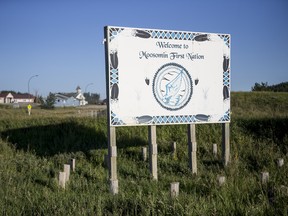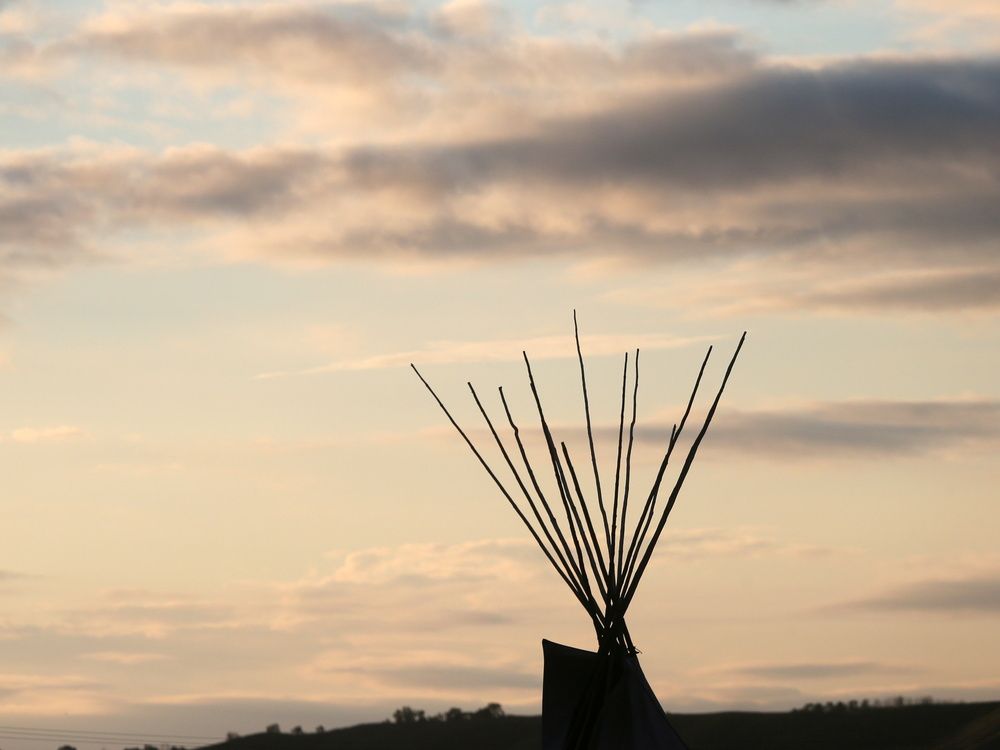IPECTA could be a ‘model’ for a world in ecological crisis, because it ‘takes trade in a different direction’

Article content
Wayne Garnons-Williams, a trade lawyer from Moosomin First Nation in Saskatchewan, has had enough of the “European” way of doing business. Exhausting resources at the cheapest possible cost benefits a company’s shareholders and no one else, he said. “That’s not the only method out there. It happens to be the European method. And look at what it’s got us. Yes, it’s got us a vibrant economy. But at what cost? What environmental cost?”
Advertisement 2
Article content
Garnons-Williams was the lead Canadian Indigenous representative at the negotiations that resulted in the Indigenous Peoples Economic and Trade Cooperation Arrangement (IPETCA). A small group of countries with fraught histories of Indigenous relations — Canada, Australia, Taiwan, and New Zealand — came together on June 24 to launch the arrangement, and in doing so, committed to better integrating Aboriginal businesses into the global economy.
IPETCA could do more than just boost exports from First Nations such as Moosomin, a community of about 2,000 on- and off-reserve members that control nearly five million acres north of North Battleford, according to the nation’s website.

The new pact could be a “model” for a world in ecological crisis, because it “takes trade in a different direction,” said Garnons-Williams, who thinks the world would be different if colonizers had sought to incorporate their belief in capitalism and rapid industrialization with the worldview of the Indigenous peoples.
Advertisement 3
Article content
According to Indigenous thought, “we’re not at the top of the apex looking down on the rest of the world, and we’re not superior to the animals and the trees, and all living beings,” Garnons-Williams said. “We live within the biosphere. We rely on it. And so Indigenous philosophy is that we have a responsibility to give back and to take only what you need when you use the resource.”
International power brokers such as European Central Bank president Christine Lagarde and Royal Bank of Canada chief executive Dave McKay have endorsed this green worldview. McKay’s institution, the country’s biggest company by market capitalization, produced a report earlier this year that argued involving Indigenous communities could accelerate Canada’s efforts to create an economy that generates no net carbon emissions. Among the report’s assertions: “Incorporating Indigenous values and traditional knowledge in the transition will lead to more sustainable and profitable outcomes.”
Advertisement 4
Article content
The recognition is centuries too late, and hardly makes up for the pain European settlers and their descendants inflicted on millions of people, but Indigenous people are finally getting a say in how the world works.
(IPETCA) ensures that the interests of the Indigenous people be the first thought, and not an afterthought
Lisa Smith
“(IPETCA) ensures that the interests of the Indigenous people be the first thought, and not an afterthought,” Lisa Smith, president of the Métis Nation of British Columbia, said at the IPETCA endorsement ceremony in June. “As we all know, Indigenous people are quite often an afterthought.”
History of exclusion
To be sure, IPETCA is still more of a philosophy than an official trade agreement. At the moment, it lacks concrete policy measures. The initial signatories insist the policies will come, and that the process will be entrusted to Indigenous people themselves. “This is going to be by Indigenous people, for Indigenous people, and they’re going to be the ones to tell us what it is that they need,” said Mary Ng, Canada’s trade minister.
Advertisement 5
Article content
One thing Canada’s Indigenous people require, undoubtedly, is capital. First Peoples lack access to the traditional banking system, a direct result of colonial policies, former Bank of Canada deputy governor Lawrence Schembri said in a speech in May. He highlighted Section 89 of the Indian Act, which prevented Indigenous people from accessing credit.
“(IPETCA) addresses the longstanding history of Indigenous exclusion from the economies based on the deliberate isolationist policies,” Garnons-Williams said. “And that story can be retold in New Zealand, in Australia, in the United States, in Chinese Taipei — you name it.”
(IPETCA) addresses the longstanding history of Indigenous exclusion from the economies based on the deliberate isolationist policies
Wayne Garnons-Williams
In New Zealand, the British Crown purchased the land of the Indigenous Māori for unfair prices, reducing Māori landownership to just 17 per cent of what it had been in the pre-colonial era. Their Australian neighbours did not fare much better. They were also displaced from their lands, and, during the Stolen Wages period of the 1800s to 1970s, were subjected to slave labour in exchange for rations. The Taiwanese Indigenous people lost much of their land to the Chinese, until finally the Japanese terminated Indigenous land rights altogether in 1895.
Advertisement 6
Article content
It’s no surprise, then, that today, Indigenous people are economically disadvantaged. The Māori economy is referred to as a “developing economy within a developed economy.” Māori are more likely to earn less, be unemployed, rent rather than own a home, and live in worse neighbourhoods compared to their non-Indigenous counterparts. Similarly, the Australian Aboriginal and Torres Strait Islander people, as well as the Indigenous Taiwanese, earn lower wages on average.
Pending policy measures, whether IPETCA will be enough to counteract decades of systematic colonial economic oppression remains to be seen.

So far, the Māori are doing OK on their own. Despite the setbacks they have faced, the Māori have strength in numbers, and at 15 per cent of the population, are better positioned to push for political representation than their Australian Aboriginal neighbours, who comprise just three per cent of the population. The Māori own significant stakes in the New Zealand fishing, forestry, and farming industries, among others, and have amassed an estimated asset base of over $50 billion. It is just one example of the economic potential of Indigenous people when their political needs are taken into account.
Advertisement 7
Article content
Canada’s Aboriginal Peoples make up about five per cent of the population, according to the 2016 census. Some 50,000 Indigenous-owned companies contribute about $30 billion annually, according to Export Development Canada. That number is poised to grow, suggesting Indigenous Peoples will expand Canada’s overall economic potential as they reclaim treaty rights long denied them. They have an estimated $20 billion in trust assets and up to $100 billion in outstanding land claims, and potentially $100 billion more in renewable energy and critical minerals on or near their lands, according to Royal Bank.
“Incorporating Indigenous values and traditional knowledge in the transition will lead to more sustainable and profitable outcomes,” concluded the bank’s report, written by a team that included John Stackhouse, a senior vice-president, and Cynthia Leach, assistant chief economist.
Advertisement 8
Article content
‘Funding is an issue’
The Indigenous Seventh Generation Principle states that decisions taken today should result in a sustainable world seven generations into the future. The premise, which dates back to 1142 to 1500 AD, was dismissed along with other Indigenous teachings in the colonial era, and has now resurfaced amid the climate crisis. In a hypothetical scenario where IPETCA becomes the underlying principle of the world trading system, its central pillar would be “the understanding that there are limits to our resources,” Garnons-Williams said. “And that we need to factor in, as a form of economic math, that the cost of production should include giving back to that resource, to ensure that there are future resources down the line.”
Advertisement 9
Article content
For her part, Indigenous Canadian entrepreneur Nicole McLaren hopes IPETCA will secure access to mentorship. It’s due to a lack of credible advice, she said, that she ran into issues when she was expanding her Kamloops, B.C.-based subscription gift box service, Raven Reads Ltd., to the United States. McLaren discovered she couldn’t use the name “Raven Reads” for her U.S. subsidiary due to trademarking issues. “Had we had a bit more hands-on coaching earlier on and someone to flag that, obviously we would have picked a different name and done our branding differently,” she said. (McLaren renamed her U.S. subsidiary Maarsii, which means “thank you” in the Métis language.)

And as Schembri, who retired from the central bank in June, observed in his speech earlier this year, capital is also a major issue for Indigenous entrepreneurs. Cindy Crowe, who runs Niibing Tribal Tours, a tourism company based out of Neebing, Ont., about 35 kilometres southwest of Thunder Bay, said she’s being held back because it’s difficult to round up financing to build the river crossing, gazebo, and other structures she needs to generate more income from visitors who come to tour the area.
Advertisement 10
Article content
Money is especially tight now, Crowe said, given the federal government has removed pandemic-era wage subsidies even though the tourism industry has not recovered completely. “I have the necessary mentorship I require through organizations like Indigenous Tourism Ontario,” she said. “However, funding is an issue. I need capital funding to develop structures on my property for my businesses. There is great demand and competition for the funding that is available.”
A vague trade arrangement will do little to help Crowe build her gazebo. But Indigenous scholar Wanda Wuttunee, who teaches in the department of Native Studies at the University of Manitoba, believes that input from Indigenous entrepreneurs should continue to determine IPETCA’s trajectory. “I think the biggest strength (of IPETCA)… is to see how front-and-centre Indigenous perspectives are,” she said.
Advertisement 11
Article content
The arrangement, which was built with Indigenous contributions, is a milestone in the decades-long push for Aboriginal Peoples to participate in the economy as equals. “Being with us at the table, (the Indigenous people) determined what they wanted to succeed, and we listened, and we stood side by side with them,” Ng said.
It’s a departure from the norm. Indigenous voices have generally been absent in much of the research Wuttunee has done on policy collaborations between the government, Indigenous Peoples, and other stakeholders. “I want voices to be heard from the people that are going to be impacted by this, who are going to be involved in it,” Wuttunee said. “I want that to be honoured and respected.”
-

National Indigenous economic strategy launches in Canada on four pillars of people, lands, infrastructure and financing
-

Indigenomics 101: A new voice shows how to make room for First Nations at the economic table
-

The great rethink: Why Canada’s three-decade-old approach to economic management needs an overhaul
-

Environmental and economic development choices split Canada’s First Nations
Advertisement 12
Article content
But government institutions will need to walk the talk. As an editorial in the Taipei Times English-language newspaper notes, IPETCA will have a benefit only if governments act. “IPETCA should be backed up by greater opportunities for Indigenous Peoples’ economic participation at home,” it said.
Wuttunee believes there is a balance to be struck between Indigenous and Western perspectives. “It’s not a one-way street, it’s two-way.”
The approach is referred to by the Mi’kmaq as “etuaptmumk,” or “two-eyed seeing.” It refers to seeing with one eye with “the strength of Indigenous stewardship, knowledge, and ways of knowing,” and with the other eye, “the strength of Western tools and systems,” the Royal Bank report said.
Garnons-Williams concurred. He believes that going forward, the Western ideals of science and technology should be used for preservation, not for greed. IPETCA will pave the way for this “cultural and philosophical sea change,” because “we have to do something different,” he said. “We can’t continue on the way we’ve been doing it.”
• Email: mcoulton@postmedia.com | Twitter: marisacoulton


